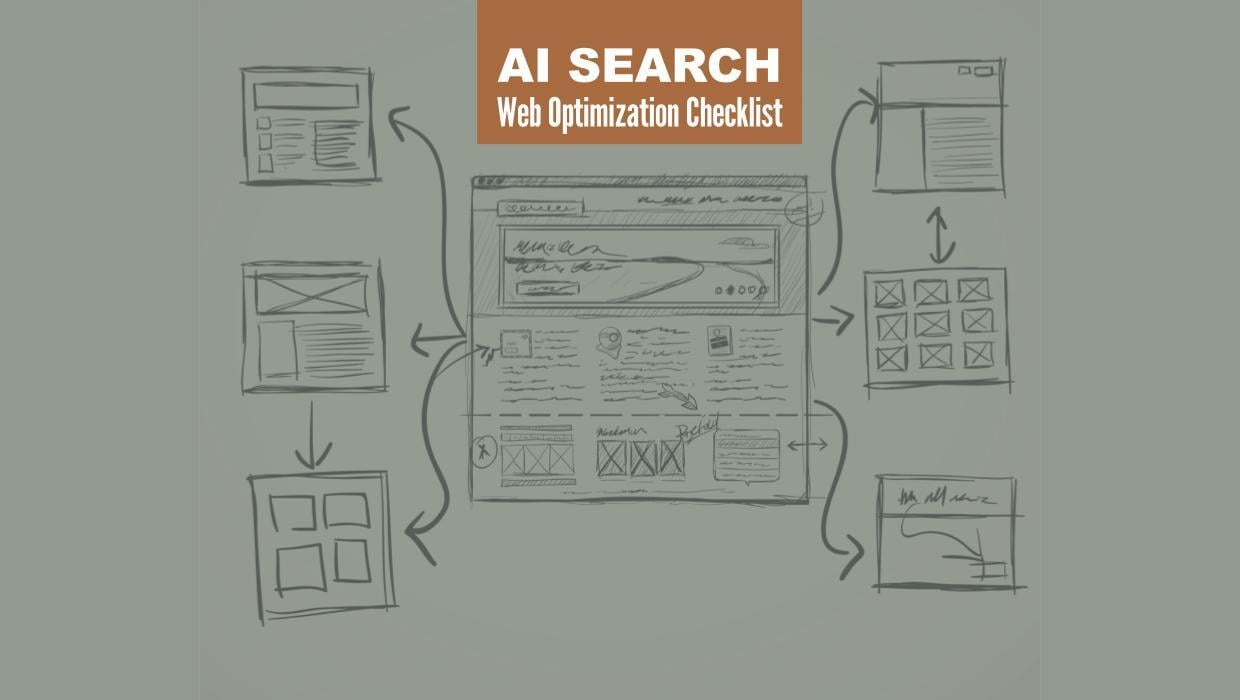How To Win At B2B Thought Leadership — No Public Speaking Required
Written by
Most B2B leaders would rather get a root canal than give a keynote speech. Yet somehow, we’ve convinced ourselves that thought leadership requires becoming the next Simon Sinek.
But what if the most effective thought leadership strategy never involves getting on a stage?
I recently sat down with storytelling coach Jay Acunzo, a two-time keynote speaker at our Experience Inbound event, and what he shared affected my thinking about thought leadership strategies for our complex B2B clients.
It’s true, many business leaders break into a cold sweat at the mention of “thought leadership.” That’s in part because they picture themselves sweating through public speaking engagements — a fear right up there with death for many people.
But my conversation with Jay confirms, this is a self-limiting mindset we need to shift. The most effective thought leadership strategies for industrial companies don’t necessarily require stages, spotlights, or public speaking.
Check out our conversation on The ChangeOver podcast below — or if you’re short on time, read the summary and come back to it later:
Watch episode 27 of The ChangeOver, then subscribe on Apple, YouTube, Spotify, Weidert.com, or your favorite podcast app.
Why Industrial Expertise Alone Isn’t Enough in 2025
Here’s what industrial leaders need to understand: even in highly technical industries, expertise has become commodified.
Your competitors know the same:
- Manufacturing processes and methodologies
- Regulatory requirements and compliance standards
- Technical specifications and industry certifications
- Supply chain optimization techniques
“Expertise is foundational — like a reporter knowing the facts. But you can’t charge a premium for it anymore.” — Jay Acunzo
What separates a successful $200M industrial distributor from its competitors isn’t what they know; it’s how they think about industry challenges and help customers think differently, too.
The Real AI Threat to Industrial Marketing
While everyone panics about AI replacing content writers, the bigger threat is more subtle. AI is flooding the market with more mediocre “how-to” content, technical guides, and industry insights. The winners will use AI to synthesize their proprietary data — customer feedback, operational insights, market patterns — and free up their human experts to share the breakthrough thinking AI can’t replicate.
Your 20-year plant manager’s experience troubleshooting complex equipment failures? Don’t let it be merely expertise — make it your intellectual property.
Building Your Industrial IP Pyramid
Instead of just sharing technical knowledge, industrial companies need to develop intellectual property around their unique perspective. Here’s a model that follows Jay’s framework:

Foundation: your industrial premise — Think of this as the one core belief that reframes how customers should think about their challenges.This isn’t a tagline, it’s a contrarian take that challenges conventional industry wisdom:
- “Preventive maintenance isn’t enough. You need predictive resilience” (challenges traditional scheduled maintenance)
- “Supply chain optimization starts with understanding your supplier’s suppliers” (goes beyond first-tier visibility)
- “Safety incidents are symptoms, not root causes; fix the decision-making environment” (reframes safety from compliance to culture)
To test your premise, complete this sentence: “Everyone in our industry thinks X, but we believe Y.”
Level 2: your language — Define terms that make your customers sound smarter in their boardroom meetings. Give them the vocabulary to articulate problems they couldn’t name before.
For example, a predictive maintenance company might define:
- “Failure debt” (the hidden cost of deferred maintenance decisions)
- “Maintenance velocity” (how quickly you can respond to predictive signals)
- “Asset resilience score” (a metric combining reliability, maintainability, and adaptability)
What problems do your customers struggle to explain to their leadership? Create terms that make those conversations easier.
Level 3: your methodology — This is your unique, step-by-step, repeatable process for solving complex industrial challenges that comes only from your specific experience. And you must make it memorable: use acronyms or alliterative phases that stick in customers’ minds.
Level 4: Your Visual Frameworks — Break your methodology into a visual framework that becomes a key screenshot in your customers’ presentations to their leadership teams. These frameworks transform your complex processes into simple, memorable diagrams that help customers justify decisions and communicate value internally. Think of formats like:
- Maturity models showing progression from basic to advanced states
- Decision trees helping navigate complex equipment or process choices
- Comparison matrices positioning solutions against key criteria
- Process flows visualizing your step-by-step approach with clear handoffs
Then put it to the whiteboard test: if someone can’t sketch your framework from memory after seeing it once, it’s too complex. The best industrial frameworks become industry shorthand — like “lean manufacturing” or “Six Sigma.”
Peak: Your Customer Stories — these are the specific transformation narratives proving your premise works in real industrial environments, complete with measurable outcomes. Structure these layers into the stories:
- Challenge: What conventional approach wasn’t working?
- Insight: How your premise revealed the real problem
- Solution: Your methodology in action (with specific tactics)
- Results: Quantified improvements (uptime, cost savings, efficiency gains)
- Quote: Customer testimonial that reinforces your premise
Psst: Check out Jay's advice on asking for customer testimonals here.
Thought Leadership for Companies That Hate the Spotlight
This might have been the important insight from my conversation with Jay: thought leadership doesn’t demand your CEO become the next industrial conference circuit star.
The power of multiple, specialized voices becomes clear when you consider how industrial buyers actually research solutions. A plant manager researching predictive maintenance doesn’t want to hear from your CEO about quarterly growth. They want insights from someone who’s actually implemented those types of systems in similar environments.
For industrial companies, this distributed expertise approach delivers three key advantages:
- Deeper credibility — When your maintenance engineer speaks about equipment reliability, prospects immediately recognize authentic experience vs. corporate messaging
- Broader market coverage — Multiple experts can engage different buyer personas simultaneously across various industry publications and forums
- Competitive differentiation — While competitors showcase generic “solutions,” you’re demonstrating actual operational knowledge
Here’s how a company might put it to work in practice:
- Your operations director owns lean manufacturing in complex environments and becomes the go-to voice for operational efficiency insights
- Your supply chain manager becomes known for supplier relationship optimization and gets quoted in logistics publications
- Your safety coordinator leads conversations about safety culture transformation in industry safety forums
- Your quality assurance lead focuses on predictive quality systems for content on manufacturing excellence
Each specialist reinforces your company’s broader premise while building personal authority in their domain. When prospects see multiple team members contributing thoughtful insights across different aspects of industrial operations, it signals depth of expertise that competitors can’t easily replicate.
Best of all, the effect compounds: a prospect might first encounter your safety coordinator’s article on culture transformation, then see your operations director’s LinkedIn post about lean implementation, then find your supply chain manager quoted in a trade publication. This multi-touchpoint exposure builds trust faster than any single executive could achieve alone.
Managing the “What If They Leave?” Risk
This is the biggest concern I hear from industrial leaders: “What if we invest in building someone’s personal brand and they go to a competitor?”
Jay’s response challenged that perspective. He pointed out that media companies face this exact issue; their trust comes from individual voices, not logos. They manage it by building systems that protect their intellectual property.
For industrial companies, this means:
- Documenting your methodologies and frameworks in brand guidelines
- Creating content templates that maintain consistency across team members
- Building a repository of customer success stories that any spokesperson can reference
- Developing multiple voices so you’re not dependent on any one person
Jay’s Three-Step Framework for Industrial Thought Leadership
Some practical advice from our conversation was Jay’s “We Want, We Need, We Hope” messaging approach, adapted for industrial contexts:
- We Want: “You want your operations to run predictably with minimal surprises”
- We Need: “You need to think beyond reactive maintenance to predictive system optimization”
- We Hope: “Imagine operations so well-tuned that problems solve themselves before they impact production”
We’re not talking about aspirational marketing, but about leading customers through a logical progression to reframe how they think about their challenges.
Why Curiosity Matters More Than Technical Knowledge
Jay’s parting insight focused on this opportunity: we’re entering an era where asking better questions matters more than having ready answers.
In industrial B2B, this means the companies that win will be those that help customers see their challenges from new angles, because customers are buying more than products or services, they’re buying your perspective on how to think about their business differently.
That perspective, grounded in your specific industrial experience, is what creates true competitive differentiation.
A Practical 30-Day Industrial Thought Leadership Launch Plan
If you’re looking to build more visibility for your expertise in the industry, here’s a straightforward way to get started:
Articulate your perspective. Most companies skip this step, but it’s the foundation for everything else. What have you learned from years of solving problems that challenges conventional industry thinking? It doesn’t need to be revolutionary, just honest and different.
Ask yourself: When customers call with problems, what do you find yourself explaining that surprises them about how things really work?
Identify who should be the voice. Look for the person on your team who already does this naturally. It’s often not the most senior person, but the one customers ask for by name when they have complex questions. Find the team member who can explain complicated processes in ways that make sense to non-technical stakeholders.
Choose one place to focus. Rather than trying to be everywhere, pick the channel where your ideal customers actually spend time when they’re researching solutions. That might mean LinkedIn for reaching decision-makers, or pitching to the trade publications your prospects already read.
Document what you already do. You’ve developed problem-solving approaches over years of experience. The goal isn’t to invent something new; it’s to articulate what you already do in a way that customers can understand and remember.
Lead with outcomes. When you start sharing content, begin with what happened for your customers, not what you’re capable of doing. People in industrial markets care about results, not capabilities.
The goal isn't to become famous. It’s to become the obvious choice when prospects face their most complex challenges.
Listen to my full conversation with Jay on The ChangeOver podcast for a deeper dive into his frameworks for helping experts communicate breakthrough thinking — no conference stages required.
Subscribe To Our Blog
Information. Insights. Ideas. Get notified every time a new Weidert Group blog article is published – subscribe now!
You May Also Like...

Search Engine Optimization
Optimize Your Industrial Website for AI Search

Marketing Technology
Why Unified Data Efforts Fail (and How Manufacturers Can Fix It)

Search Engine Optimization
How Falcon Rebuilt Industrial AI Search Visibility in 2025
Accelerate Your Growth with
Weidert Group
If you’re ready to explore a partnership, request a personalized consultation with our team.

